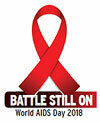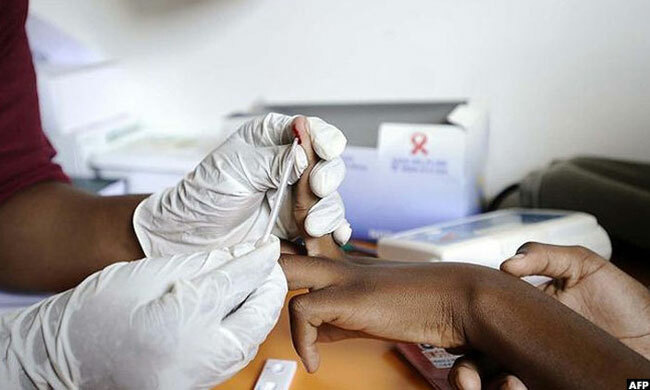Born with HIV: Adolescents join the fight
Here is a real life story of a young Ugandan woman who learnt about her HIV status at 11 years when her mother disclosed it to her.
PIC: Gloria Nawanyaga speaking during an HIV sensitisation workshop
UNITED AGAINST HIV/AIDS

In the run-up to World AIDS Day (December 1), for the whole of November, Vision Group media platforms are airing and publishing in-depth articles about the disease. Today Agnes Kyotalengerire looks at the generation born with HIV and is now of age. She explores their challenges and how they are being addressed in the communities and at policy level. Below is a real life story of 21-year-old Gloria Nawanyaga who has over come stigma and is now a global ambassador for students HIV awareness.
#Get Tested4HIV
______________________________
I learnt about my HIV status at 11 years when my mother disclosed it to me. Prior to that, I would ask her why she would take me to hospital every week for treatment and why I ended up missing school.
At first she feared to tell me, but did so after I insisted. One day she took me out. As we chatted, she asked me if I knew about HIV.
"People who get infected with HIV die," I told her.
She looked frightened. I knew something was wrong. She then asked what would happen if I discovered that I was HIV-positive. The question scared me. I knew if I had HIV, I would die.
Seeing my sadness, my mother abandoned the conversation.
One day, she took me to Makerere University's John Hopkins University, where I met many young people living with HIV. She wanted me to know that there were many young people who had HIV, but were healthy and happy.
I was not yet convinced.
I always wondered why me. I hated myself. I always asked my mother why she did such a thing to me. Why she infected me with death. I had not yet accepted the situation. I judged her harshly.
Teacher fuels stigma
One day, a concerned teacher asked why I was always absent. I feared to tell him the truth. When he assured me he was a professional counsellor and would keep the information confidential, I told him I was HIV-positive.
He did not keep his word.
He told all and sundry how I was HIV-positive. Before I knew it, fellow pupils were asking me whether I was HIV-positive. I wanted to die.
When I joined Primary Seven in the boarding section, I was put under the matron's care. I would go to her after super to take medicine. Given the stigma, I feared frequenting the matron's place for drugs. The matron was not bothered and my mum did not monitor me. For one year I did not take medicine.
I was healthy, as it seemed. But in the holidays, I suffered constant malaria, cough and flu.
When I joined Senior One in Bethel High School in Bunamwaya on Entebbe Road I fell terribly ill. My viral load was high and the CD4 count had dropped terribly. The medics were very harsh. I was scared. I thought I would die.
I was started on ARVs. I got severe reaction. Besides, the pill burden had increased from one to four daily. I developed a rash, vomited constantly and lost weight. I stopped going to school.
But the worst was yet to come.
When I was admitted to the Joint Clinical Research Centre in Mengo, I shared a room with two severely-ill women, whom I watched die. I was traumatised. I thought I would be the next. However, I got better.

Resuming school
I resumed studies in the second term after changing to a day school in Ggaba for easy monitoring. The standards in the new school were poor. I moved to another in Kabalagala. But I ran away before the close of the term due to stigma.
A neighbour who knew about my HIV status spread the word. This hit me hard as I had not recovered from the previous experience. At one point, I joined a treatment programme called Breather which required me to be away from school for some days.
A teacher demanded to know what my problem was.
Given the stigma I had encountered earlier, I lied to her that I had cancer of the blood. The lie did not help. Rumours that I had HIV swept through the school like a wildfire. One day, the teacher demanded to know the truth. She was so hard on me. I told her the truth. She took it personal. She accused me of wanting to infect the boys in the school.
It was another hard blow.
Again I almost dropped out of school. I did not tell my mother all this. Instead I would leave home and hide in the playground while others attended lessons. However, later I told my mother my pain and requested her to take me back to Bethel High School.
My uncle was a teacher there and no one knew my status. I became a headgirl. I passed my UCE and joined S5 in St Charles Lwanga in Kakiri.
I turned to God to heal me but instead I developed herpes zosta. God heals, but I had to take my drugs, I learnt the lesson the hard way.
I passed Senior Four and joined Uganda Christian University Mukono (UCU) for law in 2016.
Stigma continues
The stigma just would not go. A girl requested to share a room with me. To my surprise, she moved in with her boyfriend. I bore the humiliation since I depended on them for upkeep.
With time, they became inquisitive about my medication. But I would brush them off. Then the unimaginable happened. My friend's lover made advances on me. I turned him down and his ego was bruised. In revenge, he devised a way to hit back at me.
While I was away, he found the ARVs and told my friend I was trying to lure him into sex yet I was HIV-positive.
I tried to explain to my friend in vain. She called me a slut and other ugly names. The news spread to the university. Everyone hated me. It was too much to bear. I contemplated suicide. I left the hostel for three days to stay at a friend's place.
While there, I realised I could not run away from the stigma.
So, I returned to the university determined to face stigma squarely. That semester I performed to my best. Then I got to know about the Young Positives beauty pageant. I felt I needed to prove a point. Fortunately, I won the national contest and became Miss Young Positives 2017-2018.

Now, I carry out school outreaches, sensitising young people about HIV. I spread the message that HIV is not the end of life.
I am also a peer educator and a global ambassador for students HIV awareness. Love/sexual relationship Being a beautiful girl, men approach me all the time, but I do not encourage them.
When I say the truth, some men ask how many men I slept with to contract the virus. They do not know I was born with HIV.
Managing adolescence
Gloria Nawanyaga, 21, a third year law student at UCU is one of the 79,000 adolescents living with HIV.
Just like Nawanyaga, the HIV-positive young people are now of age and are grappling with stigma, disclosure and drug adherence.
Rose Nassejje, the child, adolescent and youth technical service specialist working with The AIDS Support Organisation (TASO), acknowledges self-stigma is a big challenge.
She says the problem is often addressed through the peer led counselling model with support from professional counsellors.
"We consider those who have adhered to medication, suppressed their viral and are healthy. The peer to peer visits and interaction helps to lift their self-esteem."
Dr Violet Nabatte, the head of paediatrician and adolescent services at Mildmay Uganda, cites cases of those who have been hit by stigma, but they have come out of it successfully.
However, Nabatte attributes the success to counselling which has to go on throughout life.
"When interacting with them, we always ask questions such as how to they interact with others. How they got to know their status, how many people know their status? what their reaction was when they got to know your HIV status.
"Basing on their reaction and responses, we are able to identify those who are still grappling with stigma or disclosure issues and we continue counselling them to support them through," she explains.
You might also be interested in this:
Addressing HIV/AIDS: Y+ pageant regional search
Tackling HIV: Ugandans shine in Amsterdam
Disclosure of HIV status
Nabatte says according to the policy by the health ministry, by 10 years of age, parents should tell their children about their HIV status.
"Of course we have to judge their understanding and decide whether they are mature enough to comprehend the information that is given to them," she explains and adds that this is done in a specified approach.
"Usually the caretakers (for example parents, grandparents or any other person) are empowered to disclose to them because they are the ones entrusted to take care of them.
"However, not every adult can manage to handle disclosure, some of them opt to do the disclosure in hospital, but with our support. We sit caretakers and the child and talk. It is a process that we start and then monitor the child's response which allows us whether to continue, until the whole package is finished or give it another step, until they come back.
"At every clinic visit we keep monitoring to see if the process is complete and monitor the child's reaction to disclosure because it has an impact on them," Nabatte explains.
Adherence and taking drugs
Peer pressure and hormonal influence are common causes of poor drug adherence. Some people are taken up by social activities such as partying and they forget to take medicine.
Others stop taking medicine, just like the case of Nawanyaga, because they are healthy and are not falling sick.
Nevertheless, Nabata says every time they come to the clinic to pick their medicines, the health workers do a check on adherence and also counsel and encourage them to continue taking their medication.
Policy level
Dr Cordelia Katureebe, the national co-ordinator for HIV care and treatment at the health ministry, says handling young people living with HIV requires a multi-sectoral approach.
"For instance, we engage other sectors in care apart from health. In terms of the psychosocial support we look at the children's surrounding; are they vulnerable or what their school issues are," she says.
For disclosure of the HIV status from the parent to the child, the health ministry has provided guidelines, including the psychosocial support for some of those process so that by a certain age the child gets to know their HIV status.
"We know that once they are disclosed to they are able to cope much better, especially when having to take medicine for life," Katureebe explains.
The component of psychosocial support is meant to equip the child to deal with stigma, anger and life skills and issues around self-esteem.
To address issues of stigma, in relation to the children in school, under the education ministry together with the health ministry have designed a school health policy with HIV integrated.
The policy provides guidance to the school nurses who belong to the health ministry and matrons to support some of those processes including adherence which is the biggest challenge.
"As they get into the adolescent stage, the start asking many questions and stop adhering to drugs," she notes.
This ultimately leads to unsuppressed viral load.
According to Katureebe, this is reflected in the viral load suppression across the country which is worst among the children and adolescents. She estimates that is ranges from 54% to 77% compared to the 89% with adults.
As the children grow up the sexual and reproductive issues set in which is natural, Katureebe says. Part of the information given to them is how to deal with relationships.
The health workers, through counselling, handle them case-by-case advising them on how to get into a meaning relationship. Ultimately, they are empowered to make sexual and reproductive health decisions.
Strategies
According to Nabattee, the biggest strategy is to strengthen the youth-friendly services and have trained health workers to handle adolescents while understanding their issues.
She acknowledges that the generation of children born with HIV has grown over time.
Statistics on HIV prevalence
According to the UNAIDS 2017 estimates, the new infection rate stands at 50,000. The same report estimates a total of 1.3 million people are living with HIV in Uganda.
The routine data indicates that the number of people who have tested and know their status is 1,084,000 while 1,082,000 are enrolled in care which translates to 86% of those in need of treatment.
The Uganda Population Based HIV Impact Assessment (UPHIA) report 2017 indicates that annually 20,000 people die of HIV and less than 4,000 babies are born with HIV every year as opposed to 30,000 babies who were born with HIV 2011.
This means that the Prevention of Mother To Child Transmission (PMTCT) programme is making progress, especially among women because they are able to access antenatal care services, where they are tested and started on treatment.
In terms of prevalence, the same report indicates a reduction from 6.2% to 7.3%, which is still unacceptably high.
Also related to this story
How HIV/AIDS fight started in Uganda
Is cancer the new face of HIV/AIDS?
HIV/AIDS pandemic lingers despite successes